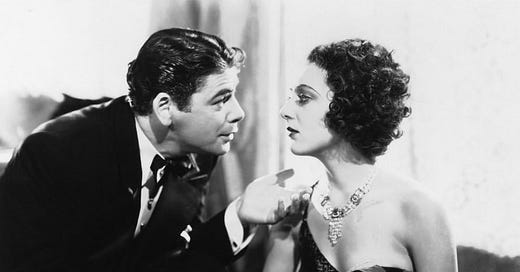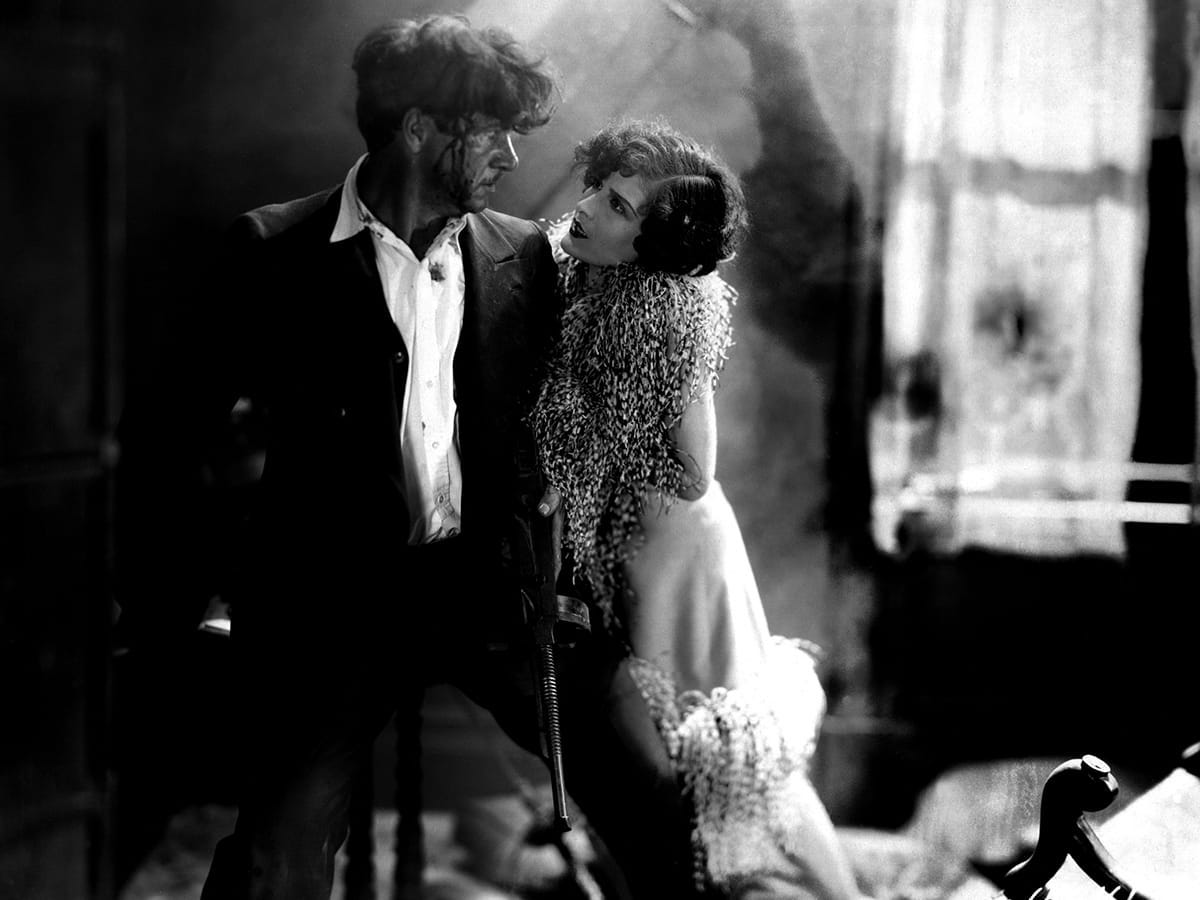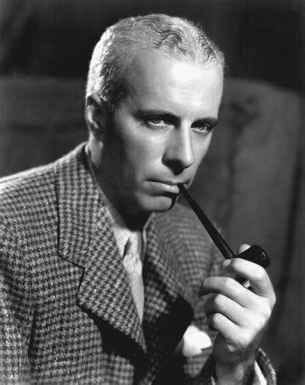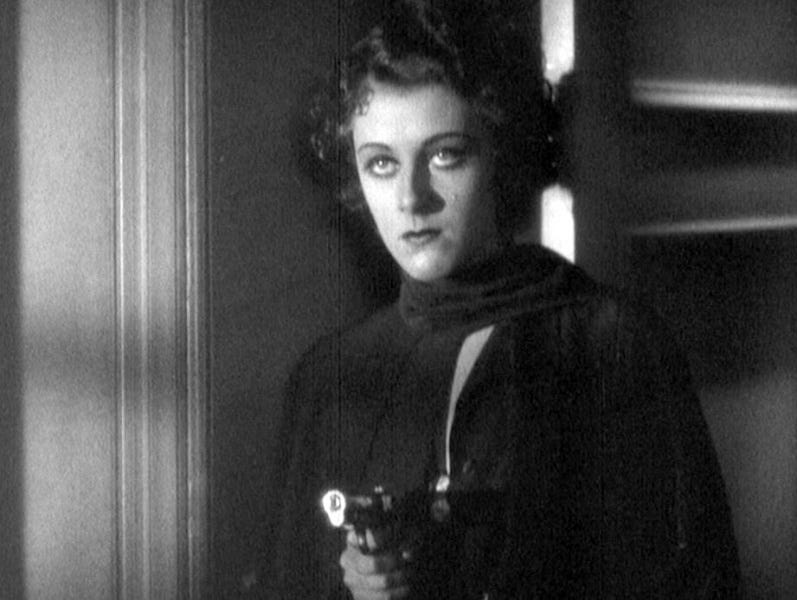I have a confession to make before I start this post: I have never seen the Brian de Palma Scarface starring Al Pacino. There, I said it. I promise, I will get around to it soon, but I am glad that I saw the original Scarface first, because I didn’t have any preconceived ideas of what it would be.
I thought the 1932 Scarface was a terrific film that was way ahead of its time in terms of sound design, camerawork, and most of all the performances. Similar to last week’s film A Woman of Paris, Scarface’s performers don’t try to ‘sell’ their performances to us. They inhabit them. Especially Paul Muni who plays Tony Camonte. More on his performance in a moment, but first let’s dive into the specifics of the film itself.
Scarface is loosely based on the novel of the same name written by Armitage Trail, which was inspired by the life and crimes of Al Capone. Ben Hecht wrote the screenplay for the film, which aligned well with his past experience as a journalist at the Chicago Daily News, which spanned the same time frame as Al Capone’s heyday in the organized crime world in Chicago. Hecht was largely responsible for the beginning of the gangster genre in Hollywood, starting with the silent film Underworld (1927), directed by Josef Von Sternberg.
Howard Hughes, noted eccentric and producer of Scarface, wanted to capitalize on the success of gangster films in Hollywood like the James Cagney starring film The Public Enemy (1931). He specifically wanted to do a story about Al Capone. After hiring Hecht to write the script, his first choice of director was Howard Hawks, even though he was currently suing him. You read that right. Hughes believed that Hawks had plagiarized his film Hell’s Angels, so he filed a lawsuit against him. While playing golf together, Hughes told Hawks that he would drop the charges if he would direct Scarface.
Despite the rocky beginnings, Hawks had a lot of fun on the set of Scarface, and you can tell! Hawks is known for his fast-paced comedies like Bringing Up Baby (1938) and His Girl Friday (1940), and even though those films might not seem similar to Scarface on the surface, Hawks infuses comedy all throughout the gangster film in very clever ways. My personal favorite is when Tony’s secretary (who is illiterate, which is a great bit on its own) is on a phone call in the restaurant while the building is being shot up. Instead of looking for cover, he remains on the phone call because he’d rather get shot than fuck up his job again.
Scarface tells the story of Tony Camonte, an ambitious and unhinged gangster who is determined to rise in the Chicago underworld. At the beginning of the film, he carries out a hit on his boss Big Louie on behalf of South Side mobster Johnny Lovo (played by Osgood Perkins, father of Anthony Perkins!) Johnny promotes Tony to number two in-command for accomplishing this, but Tony has more ladders he wants to climb, which ultimately leads to tensions between Johnny and Tony.
The film also delves into Tony’s personal life with his family, especially his relationship with his sister Cesca, which seemed to me to be borderline incestuous. The first time we see them, his sister is with a man around her age and Tony threatens him with violence to leave her alone.
Tony and Cesca’s mother also plays an important role in the film that ended up changing over time. Originally, Tony’s mother was written as a supportive figure in Tony’s life, but Hawks met with the folks of the Motion Picture Producers and Distributors of America (MPPDA) to discuss changes that they wanted to make to the film. The MPPDA was concerned that if the characters around Tony were supportive of his behavior that audiences would hold Tony up as a hero. They wanted to make sure that audiences knew that being a gangster was BAD, so they suggested that they make Tony’s mother a more outspoken critic of his activities.
A quick note about pre-code films:
Pre-code refers to the period of cinema before the Hays code was implemented by Will Hays, the leader of the MPPDA. The production code was started in 1930, but wasn’t widely enforced until 1934, thus making Scarface a pre-code film. The Hays code listed acceptable and unacceptable content that films could use. Here are some examples of what the code deemed “acceptable” vs. what they deemed “unacceptable” -
“Acceptable”
Crime and sinful behavior - Could only be shown if it was punished or condemned.
Marriage & Sex - Could be referenced but had to uphold traditional moral standards.
Religious Faith - Could be portrayed, but not mocked.
Drunkenness and Addiction - Could be shown, but not glorified.
Violence - Allowed, if not excessive or sadistic.
Kissing & Romance - Allowed within moral bounds (no prolonged or passionate kissing between unmarried individuals.
Comedy & Satire - Permitted if it didn't ridicule sacred institutions like religion or government.
Depiction of Law Enforcement – Officers and justice officials had to be shown as noble and honorable.
“Unacceptable”
Nudity and Sexual Content – No explicit nudity, sex, or suggestive dances.
Adultery & Illicit Romance – Could not be presented in a positive or sympathetic light.
Profanity – Forbidden words included "God," "Jesus" (used irreverently), and any vulgar language.
Homosexuality – Considered "perversion" and was banned from films.
Miscegenation (Interracial Relationships) – Depictions of romance between people of different races were prohibited.
Glorification of Crime – Criminals could not be portrayed as heroes or have happy endings.
Blasphemy & Religious Mockery – Disrespecting religion was banned.
Excessive Violence & Brutality – Graphic violence, torture, and gruesome deaths were restricted.
Drug Use – Could not be shown unless as a negative lesson.
Sympathy for Criminals or Immorality – Films couldn't make audiences sympathize with wrongdoers.
Suicide – Couldn't be presented as an acceptable solution to problems.
Ridiculing Marriage or Family – Marriage had to be upheld as sacred.
These strict guidelines for motion pictures were in effect from 1934 all the way until 1968, when the MPAA rating system was created to give productions much more artistic freedom. The Scarface that graced the silver screen in 1932 could have been a much different film if it had to adhere to all of these guidelines.
In fact, it almost was. The hays office was adamant that the ending of the film didn’t punish Tony enough… (apparently him getting shot up at the end isn’t justice), so there was an alternative ending for the film that was shot. It’s available to watch on the latest Criterion release, and it really hits you over the head with how BAD Tony is for being a gangster and how he needs to pay for his crimes. I would argue the original ending did that as well, but the lovely folks at the production code office wanted to make sure audiences knew that being tried and convicted… and then killed was the only path towards justice! Essentially the alternate ending shows him being sentenced to death for his crimes and ends with him being hanged instead of finishing the film with the shootout. Thankfully, Hawks and Hughes fought for the original ending, which ended up being the version that was released to theaters.
The Performances in Scarface
Earlier I spoke about Paul Muni’s immersive performance as Tony, and I wanted to delve a little more into his performance, as well as some of the supporting performances in this film.
Muni was a theatre trained actor and performed in Yiddish theatre productions in Chicago. Ben Hecht thought Muni would be great for the part, but was worried that he may not have the experience necessary to play such a tough character. So before the audition, Hecht taught Muni how to throw and receive a punch.
Muni’s performance is terrifying, as he embodies the role of Tony so believably. We always think of Marlon Brando of bringing method acting to the screen, but I would argue that Paul Muni’s performance is an early example of ‘method’ acting. You can see how his performance in this alone was a template for anti-heroes to come. Even though we can recognize that the things that this character is doing are terrible, there’s a certain charm to him that’s unshakable. In the first moments of the film, when he strikes a match on the officer’s badge. In some way, he’s living out the fantasy of how we all wish we could respond to authority. The next moment is a great example though of how each action in this film does have a consequence. Instead of just letting it slide, the officer punches him in the face. A great touch by director Howard Hawks.
Ann Dvorak gives a stellar performance as Cesca in this film. She plays a character who wants to have freedom, but is constrained by her over protective and smothering older brother. It reminded me of the dynamic between J.J. Hunsecker (Burt Lancaster) and his sister Susie in Sweet Smell of Success (1957). In that film, Burt Lancaster plays a ruthless gossip columnist who is attempting to use his own paper and footman (Tony Curtis) to discredit the reputation of his younger sister Susie’s new boyfriend. Tony seems to have the same goal in this film, to protect her sister from the men who are interested in her. Why is this? I think the film subtly lays out that he has romantic feelings for her. The scenes with the two of them are intentionally uncomfortable. Where Tony finds glee in killing and doesn’t seem affected by violence whatsoever, when it comes to seeing his sister being courted by other men, he flies off the handle. In a confrontation that I mentioned earlier between the two of them after he kicks a young man out of the doorway for kissing his sister, Cesca briefly mentions that Tony doesn’t act like her brother, “he acts like—” then is cut off by Tony who continues berating and yelling at her for going out with other men.
I don’t want to spoil too much about the end of the film, but there are scenes with the two of them that are lit differently than the rest of the film. There’s an erotic nature to them that seems like it had to be intentional. It’s funny to think that the production offices had an issue with the end of the film, but didn’t seem to care about the incest that the film alludes to.
The Sound Design
Sound was relatively new in films in 1931 when Scarface was filmed. Sound was introduced to films in the late 1920’s, and by this time films were experimenting with how to use dialogue and sound effects in a way that still propelled the story forward. It may sound simple now, but filmmakers really did not know how to implement dialogue in a natural way. In silent films, the dialogue was interrupted by title cards, which relayed the information about the story that audiences absolutely needed to know. We’re so used to sound films now, that it might seem ridiculous, but people did see this as more efficient at the time. Dialogue was seen as an impediment to action, which it certainly can be if it’s not done artistically.
That is definitely not the case for Scarface, and that’s why it’s seen as a monumental film in terms of its sound design. Many sound films at the time had dialogue that was frankly overwritten and sucked out momentum that a silent film wouldn’t have any trouble with. Scarface was able to blend dialogue in with the action, as well as finding clever ways to tell the story specifically with sound. I think of the beginning of the film when Tony is whistling just before he carries the hit out on his boss. Without any dialogue, it created a tension that would carry out through the rest of the film.
There is so much to discuss with this film, and I know I only covered a small portion of what makes it so great! If you have anything you want to contribute, make sure to drop a comment below!
Next week, we’ll be fast forwarding about 92 years to 2024’s Baby Reindeer. I know it’s technically a miniseries, but I thought it was such a fabulous piece of filmmaking and I’ve been thinking a lot about it since I finished it last month. Hope to see you then! If you like what you’ve read please make sure to subscribe, and consider becoming a paid subscriber. For only $5 (or $50/year) you will have access to the full From the Vaults archive, which is fairly lengthy!







